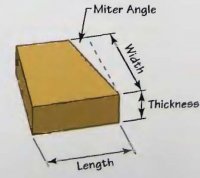When you specify the wall thickness, you are really specifying the amount of surface area where glue exists between two rows assuming that the wall profile is perfectly vertical at that point. For example, if you have two rows where the outside and inside diameters are exactly the same and specify a wall width of .5", the glue width between those two rows will be .5". Obviously, your wall profile is curved so the software uses a LOT of trigonometry to determine what the slope of the wall profile at every row of the vessel and then calculates what the inside diameter needs to be so that you will still have a wall thickness of 5" after the vessel is turned, regardless of the profile at that elevation.
Where this gets dicey is when the wall profile changes dramatically in a short distance. I've put in a lot of code to try to accommodate this occurrence and the software does the best job it can, even though there isn't enough data available to handle every situation.
There is one important thing to consider regarding the wall profile and that is at the bottom of the bowl where the rows have to transition from a narrow profile to become wider at the base. The next to the last dot is what tells the software where to start this transition. If you place that dot near the bottom, only the bottom or two segmented rows will be used in the transition. If you move that dot along the profile so that it is two inches from the bottom, you'll see that the transition to wider segments will start at two inches from the bottom of the bowl. This is hard to describe but easy to demonstrate. Just open any profile and move the next-to-last dot to be higher on the wall profile and watch what happens to the bottom of the bowl.
Lloyd

